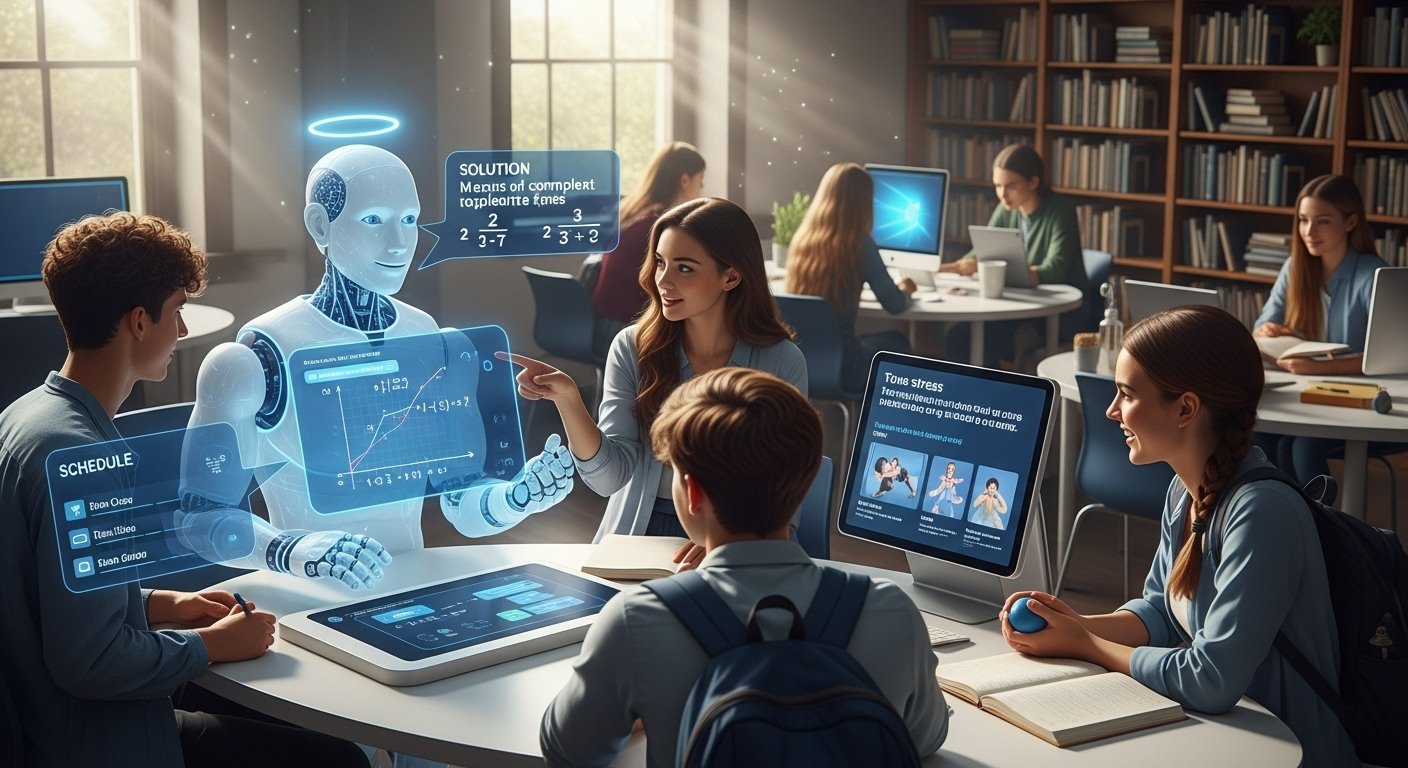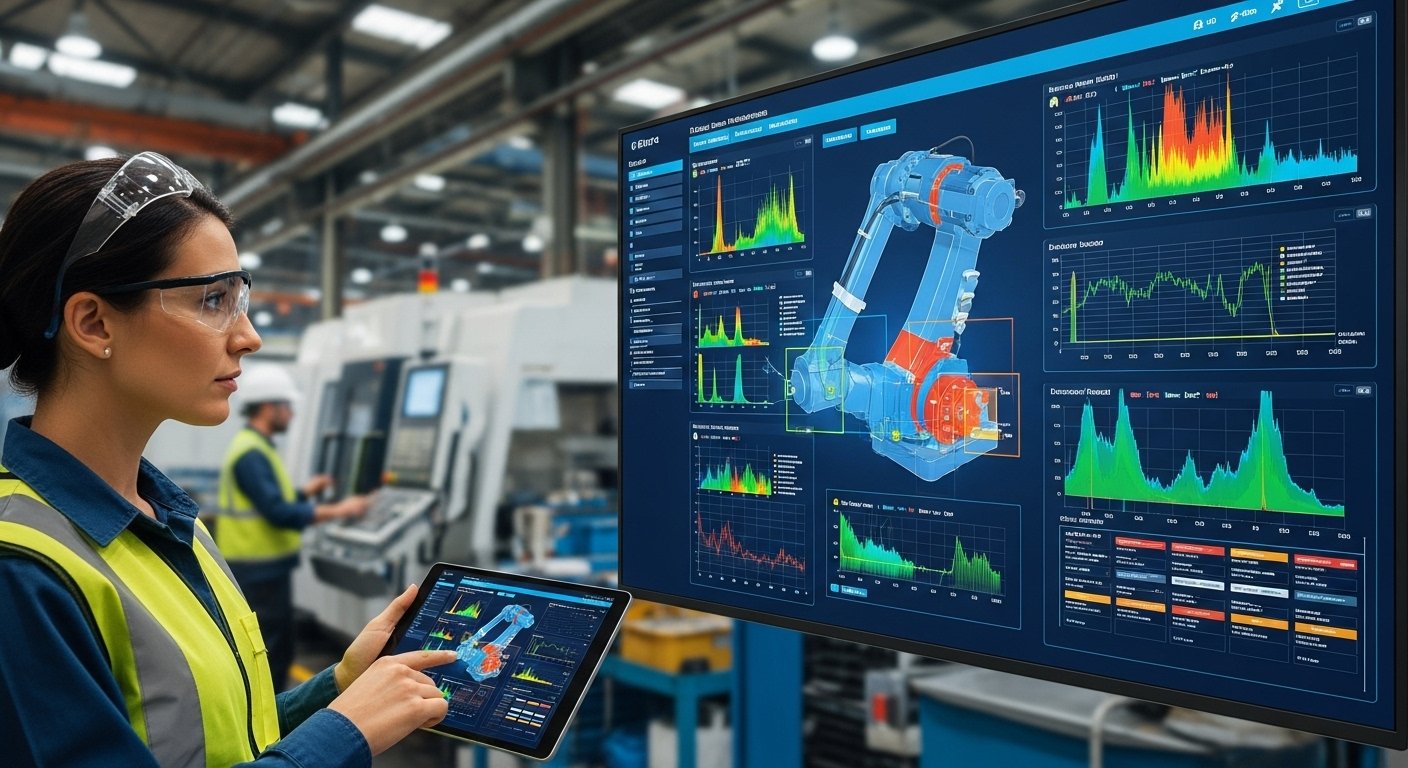Imagine waking up in the morning: your phone alarm rings, your smart coffee maker starts brewing, and your fitness tracker already analyzed your sleep. Later, Google Maps reroutes you to work to avoid a traffic jam, while Spotify curates the perfect playlist to match your mood.
What’s behind all of this? Artificial Intelligence (AI).
Far from being a futuristic fantasy, AI has quietly woven itself into almost every corner of our daily lives. We use it when we shop, work, learn, communicate, and even relax. In fact, many of us interact with AI dozens of times a day without even realizing it.
This article will guide you through an AI in daily life infographic and explain how this technology works in practice. You’ll see real examples, discover its benefits, and gain a clearer understanding of how AI supports modern living.
What Is AI in Daily Life?
AI, or Artificial Intelligence, refers to the simulation of human intelligence by machines that can learn, reason, and make decisions. Unlike traditional software, which follows fixed instructions, AI can analyze data, identify patterns, and adapt based on experience.
In daily life, AI shows up in tools we often take for granted:
-
Your voice assistant that understands natural language.
-
Your bank app that detects suspicious transactions.
-
Your streaming service that seems to “just know” what you want to watch next.
In other words, AI doesn’t just live in research labs or Silicon Valley offices—it lives in your pocket, home, car, and workplace.
AI in Daily Life Infographic: Key Areas of Impact
The infographic below (visual idea: a day-in-the-life cycle) can be summarized into five core areas where AI is shaping human routines:
1. Smartphones and Digital Assistants
Smartphones are arguably the gateway to AI for most people. Nearly every modern device runs on AI-powered features:
-
Voice Assistants: Siri, Google Assistant, and Alexa respond to natural speech, set reminders, and even control smart homes.
-
Personalization: Predictive text, autocorrect, and language translation tools make communication faster and smoother.
-
Security: Face and fingerprint recognition use machine learning to improve authentication accuracy.
Example: Apple’s Face ID scans over 30,000 points on your face and adapts as your appearance changes—whether you grow a beard or wear glasses.
2. Entertainment and Shopping
From music playlists to shopping carts, AI drives personalized experiences.
-
Streaming Recommendations: Netflix and Spotify use collaborative filtering and deep learning to suggest content based on your past choices.
-
E-commerce Personalization: Amazon’s product suggestions and dynamic pricing algorithms are powered by AI.
-
Social Media Algorithms: Facebook, Instagram, and TikTok curate feeds to maximize engagement using AI models.
Example: YouTube’s recommendation system is responsible for more than 70% of the platform’s watch time, showing just how influential AI can be.
3. Healthcare and Fitness
AI’s role in healthcare is expanding rapidly, both for professionals and everyday users.
-
Wearables: Devices like Fitbit or Apple Watch monitor heart rate, steps, and sleep, alerting users to health risks.
-
Diagnostic Support: AI helps doctors detect diseases earlier through image recognition in X-rays, MRIs, and scans.
-
Symptom Checkers: Tools like Ada or WebMD use AI-driven questioning to suggest possible health concerns.
Example: AI models in radiology can sometimes detect cancerous tumors with greater accuracy than human specialists, especially in early stages.
4. Transportation
Travel has become smarter and safer with AI.
-
Navigation Apps: Google Maps and Waze predict traffic patterns and suggest faster routes.
-
Ride-Hailing: Uber and Lyft use AI to match riders with drivers, optimize routes, and set pricing.
-
Autonomous Vehicles: Tesla and Waymo are pioneering self-driving cars powered by advanced AI sensors and deep learning models.
Example: AI helps Google Maps process over 20 million traffic updates daily, constantly improving accuracy.
5. Finance and Security
AI protects our money and makes financial management easier.
-
Fraud Detection: Banks flag unusual purchases in real time, often before you even notice.
-
Chatbots: Virtual assistants like Erica (Bank of America) provide 24/7 financial support.
-
Budgeting Tools: Apps like Mint use AI to categorize spending and suggest saving strategies.
Example: Mastercard’s AI-based fraud detection system reviews 75 billion transactions each year, identifying patterns of fraud within milliseconds.
AI Tools and Benefits at a Glance
Here’s a quick reference table summarizing how AI tools impact daily life:
| AI Tool / Example | Where You Use It | Main Benefit |
|---|---|---|
| Siri / Alexa | Smartphones, Smart Homes | Hands-free control |
| Netflix AI | Entertainment | Personalized recommendations |
| Fitbit | Fitness & Health | Real-time health tracking |
| Google Maps | Travel & Navigation | Time-saving routes |
| Banking AI | Finance | Fraud detection & security |
The Benefits of AI in Daily Life
-
Convenience – AI saves time by automating repetitive tasks, from scheduling to shopping.
-
Personalization – Services adapt to your preferences, creating more satisfying experiences.
-
Efficiency – AI reduces friction, whether by rerouting you from traffic or helping you pay bills faster.
-
Safety – From fraud alerts to self-driving car safety features, AI improves security.
-
Health Insights – AI-powered health tracking encourages preventive care and lifestyle improvements.
Tips for Using AI Effectively
-
Stay aware of privacy settings on devices and apps to control how much data AI systems use.
-
Leverage AI for productivity—use tools like Grammarly, Notion AI, or Google Workspace smart suggestions.
-
Experiment with smart homes—AI-powered thermostats and lighting can reduce energy bills.
-
Balance AI and human judgment—while AI helps with recommendations, final decisions should remain human.
Why AI in Daily Life Matters
AI is not just a tech buzzword—it’s a practical force that makes daily life smoother, safer, and more enjoyable. By handling background processes and adapting to user needs, AI allows humans to focus on creativity, relationships, and well-being.
For a broader perspective, you can read Harvard Business Review’s article on Artificial Intelligence in the real world, which shows how these consumer benefits extend into business.
Conclusion: AI Is Already Here—and Growing
From the moment your phone wakes you up to the second you unwind with a Netflix show, AI is silently working in the background. The AI in daily life infographic shows how deeply this technology is integrated into modern routines.
AI will only become more powerful in the coming years—bringing new opportunities, smarter tools, and yes, new challenges too.
Call to Action
Start paying attention to where you encounter AI today. Once you see it, you’ll realize it’s everywhere—and the more you understand it, the better you can harness its power for your own growth and convenience.
FAQs
What is the meaning of AI in daily life?
AI in daily life refers to the use of artificial intelligence in everyday activities, such as using voice assistants, online shopping recommendations, health trackers, and navigation apps.
How does the AI in daily life infographic help?
The infographic provides a simple, visual breakdown of how AI works in common areas like healthcare, entertainment, finance, and transportation, making it easier to understand.
What are some real examples of AI in daily life?
Examples include Siri or Alexa, Google Maps traffic predictions, Netflix recommendations, banking fraud detection, and fitness trackers like Fitbit.
Why is AI important in our daily routine?
AI makes life more convenient by saving time, personalizing experiences, increasing security, and offering smarter insights in health, work, and leisure.
Where can I use AI in my everyday activities?
You can use AI in smartphones, smart homes, online shopping, social media, financial apps, healthcare devices, and even in transportation systems.








Leave a Reply